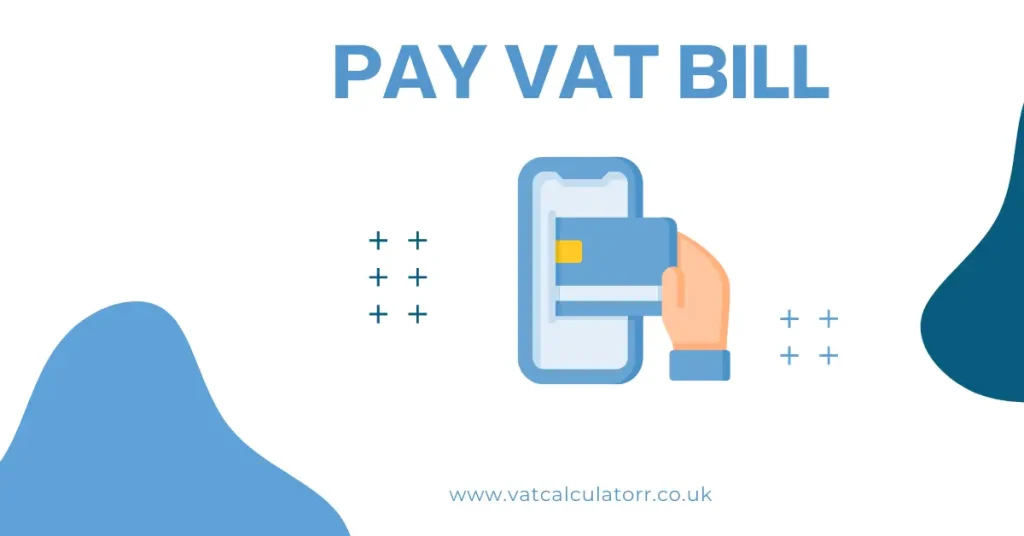How to Pay VAT Bill?
To You pay your VAT bill in the UK by choosing one of HMRC’s approved methods, such as online banking, debit or corporate card, direct bank transfer, standing order, or direct debit. You must use your 9-digit VAT registration number as a reference and ensure payment is made by the due date shown in your VAT account to avoid penalties or interest charges.

Things you should know before you pay your VAT bill.
Know Your VAT Deadline
VAT payment is due based on your accounting period quarterly or annually, depending on the VAT scheme. Missing a deadline leads to interest or penalty charges. VAT periods are shown in your online VAT account.
Businesses using the VAT Flat Rate Scheme or Annual Accounting Scheme may have different timelines. Always check the scheme before scheduling payments.
Check Your VAT Statement
The VAT statement lists the total amount due for your VAT return. Verify:
- VAT period covered
- Taxable turnover
- Deductions or adjustments (if allowed)
- Final amount due
The 9-digit VAT registration number is required. It appears in:
- Your online VAT account
- The VAT registration certificate
- Your HMRC-issued letters
Before paying, calculate VAT using the UK VAT Calculator to verify the declared total matches your invoice history.
Methods to Pay Your VAT Bill
You can pay VAT using six main methods: online bank transfer, card payment, building society deposit, standing order, direct bank transfer, or direct debit. All use the same VAT reference number.
- Online Payment
- Debit or corporate credit card
- Bank or building society
- Standing order
- Direct Bank transfer
- Direct Debit
1. Online Payment
Online bank transfers are the most common VAT payment method.
Steps:
- Sign into your online VAT account
- Select the “pay by bank” option
- Redirect to your online banking to complete the transaction
Processing time: Typically under 2 hours
This is compatible with businesses using the standard VAT method or those recently completing VAT registration..

2. Debit or Corporate Credit Card
HMRC accepts VAT payments through corporate and personal debit cards.
Card types accepted:
- Corporate credit card
- Corporate debit card
- Personal debit card
Personal credit cards are not accepted. Fee policy:
- No fee for personal debit cards
- Non-refundable surcharge for corporate cards
Payment is logged on the day of transaction, including weekends and public holidays. This allows compliance even during non-banking hours.
3. Bank or Building Society
Payments at banks or building societies must use HMRC-issued paying-in slips. Accepted forms:
- Cash
- Cheque made out to “HM Revenue and Customs only”
- Write your VAT number on the back of the cheque
Processing time: Up to 6 weeks
This option is slower than digital methods and is rarely used by VAT-registered digital service firms.
4. Standing Order
Standing orders are used when paying through the Annual Accounting Scheme or for VAT payments on account.
- Payments are fixed and automated
- Adjustments must be made manually if due amounts vary
Processing time: 3 working days
Not compatible with the Flat Rate Scheme due to differing calculation rules.
5. Direct Bank Transfer
Direct transfers include Faster Payments, CHAPS, and BACS from a UK bank account.
UK Payment Details:
- Sort code: 08 32 00
- Account number: 11963155
- Account name: HMRC VAT
International Payment Details:
- IBAN: GB36BARC20051773152391
- BIC: BARCGB22
- Account name: HMRC VAT
Processing time: Same or next working day, depending on your bank
Used for standard returns and late balance adjustments.
6. Direct Debit
Direct debits are scheduled automated payments made through your online VAT account.
Steps:
- Set up direct debit at least 3 working days before due
- Provide bank details in your VAT account
- Payment is taken on due date or next business day
Processing time: 3 to 5 working days
Once set, this method ensures ongoing compliance with VAT deadlines.
Payment Processing Times Overview
| Method | Time to Reach HMRC |
|---|---|
| Online payment | Within 2 hours |
| Debit or corporate card | Same day |
| Bank/building society | Up to 6 weeks |
| Standing order | 3 working days |
| Direct transfer (UK) | Same or next day |
| Direct debit | 3–5 working days |
Always match the method to your VAT due date and your business’s payment approval process.
Conclusion
Paying VAT on time is essential to stay within HMRC compliance. Use your VAT reference number, confirm your return figures, and choose the most reliable method for your setup.
Each method has unique timeframes. Late payments may lead to interest and penalty charges, which apply even if payments are delayed by banking processes.
Businesses registered under the VAT Flat Rate Scheme or Annual Accounting Scheme should confirm specific deadlines and payment cycles with HMRC.
FAQS
Use online banking, debit card, bank transfer, or direct debit with your VAT number as reference.
Use accurate invoices, deduct all allowed input VAT, and maintain clear records.
Yes, through the Annual Accounting Scheme if eligibility rules apply.
Yes, HMRC allows payment plans for approved businesses.
Yes, but penalties may apply if payment is not recorded by the due date.
Starts at 2% of unpaid VAT, increases based on how long it remains unpaid.
Use QuickBooks’ VAT payment function, linked to your online VAT account.
No. If due on a bank holiday, the payment is taken on the next working day.





